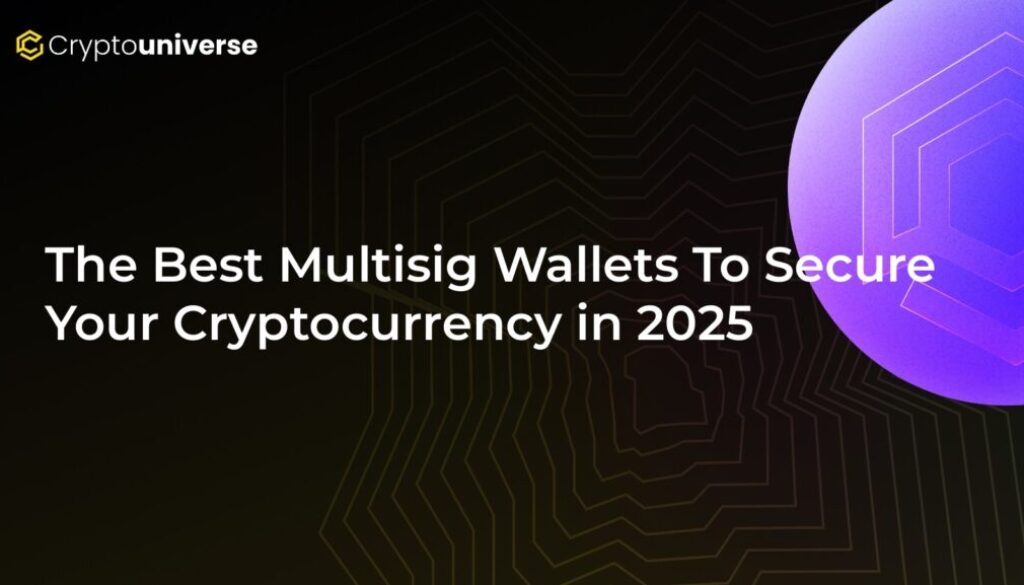The Best Multisig Wallets To Secure Your Cryptocurrency in 2025

In September 2023, hackers drained a staggering $200 million from Mixin Network. Just two months later, Poloniex lost $126 million. By February 2024, a breach at PlayDapp resulted in a $290 million loss. These weren’t isolated incidents; they were symptoms of a widespread vulnerability in crypto security: the single point of failure.
When a single compromised private key is all it takes to empty an entire wallet, you’re not managing risk—you’re gambling with it. Standard single-signature wallets, while convenient, leave the door wide open for devastating attacks. This is where multi-signature technology changes the game.
Multisig wallets eliminate this critical weakness by requiring multiple approvals for any transaction. As the digital asset space matures and hacks become more sophisticated, understanding and implementing a multisig strategy is no longer optional. This guide will walk you through The
What Is a Multisig Wallet?
A multisig (multiple-signature) wallet, often called a shared wallet, is a cryptocurrency wallet that requires two or more private keys to authorize a transaction. Think of it like a bank’s safe deposit box that needs two keys to open: one held by you and one by the bank manager. Neither party can access the contents alone.
Multisig wallets operate on an “M-of-N” configuration. For example, in a 2-of-3 setup, there are three total private keys, but only two are needed to sign and approve a transaction. This creates a powerful system of checks and balances.
Key Benefits of Using a Multisig Wallet
- Eliminates Single Points of Failure: If one of your private keys is stolen, lost, or compromised, your funds remain secure because the attacker still doesn’t have the required number of keys to move them.
- Enhanced Security: By distributing keys across different devices or individuals, you significantly reduce the risk of unauthorized access from hacks, phishing, and malware.
- Shared Custody and Governance: Multisig is perfect for businesses, DAOs, and families. It ensures that no single person can unilaterally control the funds, preventing internal fraud and enabling transparent, collaborative financial management.
- Redundancy and Recovery: In a 2-of-3 setup, if you lose one key, you can still access your funds with the other two. This provides a robust backup and recovery plan without sacrificing security.
The Top 5 Multisig Wallets for 2025
Choosing the right wallet depends on your specific needs, from asset diversity to technical comfort. Here’s a breakdown of the best options available today.
1. Ledger Multisig
Best for: Teams and individuals seeking enterprise-grade security with hardware backing.
Ledger Multisig combines the battle-tested infrastructure of Safe with Ledger’s decade of expertise in hardware security. It’s designed to address the critical flaw of software-only multisigs: blind signing. With Ledger’s Clear Signing technology, complex transaction data is translated into a human-readable format on a secure hardware device, so you know exactly what you’re approving.
- Pros:
- Hardware-backed security eliminates blind signing.
- Built on the robust and audited Safe smart contract framework.
- Advanced governance features like role-based access and spending limits.
- Supports thousands of tokens across multiple blockchains.
- Free to set up with a pay-as-you-go model.
- Cons:
- Requires Ledger hardware devices for signers to achieve maximum security.
2. Safe (formerly Gnosis Safe)
Best for: DAOs, DeFi power users, and developers on EVM chains.
Safe is the undisputed standard for multisig wallets on Ethereum and other EVM-compatible chains. It’s a fully non-custodial and open-source smart contract wallet that gives users complete control. Its modular design allows for extensive customization, making it the backbone for countless DAOs and DeFi projects. Most DeFi protocols and DAO tooling integrate with Safe natively.
- Pros:
- Highly trusted, open-source, and audited codebase.
- Deeply integrated into the DeFi and DAO ecosystems.
- Flexible and customizable with modules for spending limits, recurring transactions, and more.
- Supports transaction simulation to preview outcomes.
- Cons:
- Without hardware wallet integration, it is vulnerable to phishing and blind signing attacks.
- Interpreting raw transaction data can be challenging for beginners.
3. Electrum
Best for: Bitcoin users who prioritize speed, simplicity, and decentralization.
A veteran in the space, Electrum has been a trusted Bitcoin-only wallet since 2011. It’s a lightweight desktop client that doesn’t require downloading the entire blockchain. Electrum offers robust multisig capabilities, supporting configurations up to 15-of-15 and full compatibility with popular hardware wallets. Its decentralized server architecture enhances reliability and uptime.
- Pros:
- Fast, lightweight, and reliable.
- Strong multisig features with hardware wallet support.
- Open-source and highly reputable within the Bitcoin community.
- No third-party custody of keys.
- Cons:
- Bitcoin-only; not suitable for diversified portfolios.
- The user interface feels dated compared to modern wallets.
- Relies on SPV technology, which can have privacy trade-offs.
4. BitGo
Best for: Institutional investors, exchanges, and large enterprises.
BitGo is a heavyweight in the digital asset custody space, catering primarily to institutional clients. It offers a regulated, insured, and highly secure multisig solution designed to manage large volumes of crypto. The platform includes enterprise-grade features like compliance tools, audit trails, and sophisticated approval workflows, making it ideal for organizations with strict security protocols.
- Pros:
- Institutional-grade security with regulatory compliance and insurance options.
- Supports high-volume transaction processing.
- Advanced policy controls and detailed reporting.
- Cons:
- Complex setup and extensive onboarding process.
- Pricing structure is prohibitive for individual users or small teams.
- Less flexible and supports fewer assets than other solutions.
5. Casa
Best for: Bitcoin holders seeking a user-friendly, guided multisig experience.
Casa’s mission is to make multisig security accessible to everyone, not just technical experts. It offers a streamlined mobile app and clear, guided instructions for setting up a secure Bitcoin vault. By abstracting away much of the underlying complexity, Casa provides a service that feels simple to use while offering robust protection for your BTC.
- Pros:
- Extremely user-friendly and great for beginners.
- Excellent customer support and setup guidance.
- Mobile-first design simplifies key management.
- Cons:
- Bitcoin-only, with no support for other cryptocurrencies or DeFi.
- Subscription-based model can be costly over time.
- Less flexible for advanced users who want more control.
How to Choose the Right Multisig Wallet
Selecting the perfect multisig wallet comes down to asking the right questions:
- What assets do you need to secure? If you only hold Bitcoin, a specialized wallet like Electrum or Casa is a great choice. For a diversified portfolio with DeFi activity, you need a multi-chain solution like Ledger Multisig or Safe.
- Who is using the wallet? Are you an individual, a family setting up an inheritance, or a DAO with dozens of members? Your choice will depend on the need for governance features, user roles, and ease of collaboration.
- What is your technical comfort level? Platforms like Casa are designed for simplicity, while Safe and Electrum offer more control for advanced users.
- What level of security is non-negotiable? For maximum protection against online threats, a hardware-backed solution like Ledger Multisig is the gold standard. Software-only wallets offer convenience but come with inherent risks.
Frequently Asked Questions (FAQ)
What happens if I lose one of my multisig keys?
This is where multisig shines. In a 2-of-3 setup, losing one key is not catastrophic. You can still use the other two keys to access your funds and set up a new wallet with a replacement key. This provides a level of resilience that single-key wallets can’t match.
Are multisig wallets only for businesses?
Not at all. While they are essential for businesses and DAOs, multisig wallets are increasingly popular for individuals who want to secure significant holdings, set up trusts, or create a robust personal backup system.
What are the best practices for multisig security?
- Geographically Distribute Keys: Store each private key backup in a separate, secure physical location.
- Use Different Device Types: Combine different types of signers for your keys, such as one hardware wallet, one desktop wallet, and one mobile wallet, to diversify your security.
- Regularly Audit Signers: If you’re running an organization, periodically review who has access and what their permissions are.
- Perform a Test Transaction: Before moving a large amount of funds, always send a small test transaction to ensure your setup works as expected.
Conclusion: Make Multisig Your New Security Standard
The days of relying on a single private key to protect your digital wealth are numbered. The relentless pace of hacks and exploits has proven that single points of failure are an unacceptable risk. Multisig wallets offer a powerful, accessible, and proven solution to this problem.
By distributing control and requiring multiple approvals, you build a fortress around your assets that is resilient to both external attacks and internal mistakes. Whether you’re an individual investor, a growing business, or a decentralized organization, adopting a multisig wallet is one of the most important steps you can take to secure your crypto future in 2025 and beyond.


